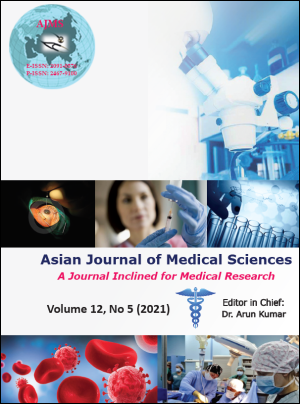Chance that matter or matter of chance: changing prevalence of fundic gland polyps and proton pump inhibitors
Keywords:
Fundic Gland Polyps, Gastric Polyps, Helicobacter pylori, Prevalence, Proton Pump InhibitorsAbstract
Background: Proton pump inhibitors (PPI) are considered one of reasons for changing prevalence of gastric fundic gland polyps (FGP), not only in western world but trend is being seen in Asian countries as well.
Aims and Objective: This study was designed to evaluate prevalence of FGP and to look into endoscopic and histological profile of these polyps in PPI users and non-PPI users. We also assessed background gastric mucosal histology in FGP patients.
Materials and Methods: This is a retrospective observational study of 1800 cases. Medical records of patients who underwent esophagogastroduodenoscopy (EGD) in three gastroenterology centres between 2011 and 2019 were analysed at Noora super speciality Hospital, Kashmir; Northern India. Biopsy specimens of patients with FGP were reviewed by expert pathologists. PPI use was quantified as significant when Pantoprazole 40 mg per day or equivalent doses of other PPI was used four times or more per week for more than one year. Statistical Analysis was conducted using SPSS version 22.
Results: FGP were most common, observed in 900 (50%) of all gastric polyp cases. PPI use one year and more was noted only in 360 (40%). FGP were mostly located in fundus 630 (70%), multiple in 840 (93.33%), with average size between 6 to 10 mm. On histology parietal cell hyperplasia, parietal cell protrusion and foveolar hyperplasia were seen in 666 (74%), 716(79.55%) and 254 (28.22%) cases respectively. Background gastric histology was normal in 543 (60.33%).
Conclusions: FGP were most common gastric polyps in Northern India. We observed similar endoscopic and histological characters in FGP irrespective of whether cases were using PPI or not. Majority of cases had normal background gastric mucosal histology.
Downloads
Downloads
Published
How to Cite
Issue
Section
License
Authors who publish with this journal agree to the following terms:
- The journal holds copyright and publishes the work under a Creative Commons CC-BY-NC license that permits use, distribution and reprduction in any medium, provided the original work is properly cited and is not used for commercial purposes. The journal should be recognised as the original publisher of this work.
- Authors are able to enter into separate, additional contractual arrangements for the non-exclusive distribution of the journal's published version of the work (e.g., post it to an institutional repository or publish it in a book), with an acknowledgement of its initial publication in this journal.
- Authors are permitted and encouraged to post their work online (e.g., in institutional repositories or on their website) prior to and during the submission process, as it can lead to productive exchanges, as well as earlier and greater citation of published work (See The Effect of Open Access).




